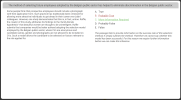

Hi, can any Watson Glaser gods out here explain how and why the approach to these 2 questions should differ? Why should I infer the statement in Q1 but cannot infer the same in Q2? With the logic of Q1 I can equally say that the Q2 statement can be inferred because the Belgian public model literally only considers relevant factors and therefore has (probably) helped / contributed to eliminate discrimination
My thinking is that:
The aim in Q1 could be racial background and gender instead of appearance (beauty), or maybe only gender, or maybe the policymakers might have simply copied another country's or EU blanket policies. To assume that the Belgian model is necessarily related to appearance just because the previous sentences talks about how appearances can be a ground for discrimination is stretching too far, let alone saying it is the aim (It could be an unintended benefit that wasn't in the mind of Belgian policy makers)
I think Q2 is more easily Probably True because it's both logical and common sense that anonymised candidate selection CAN HELP reduce if not eliminate a lot of discrimination based on appearance / gender / racial background. How do you racially / gender / looks discriminate someone if you have no info on those areas? It has to be a NET POSITIVE don't you think?

